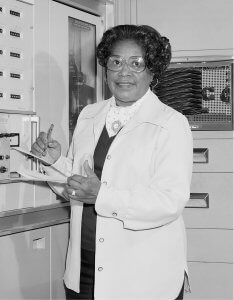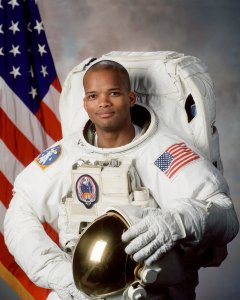Blogs | 2.22.2021
Black History Month: Celebrating African American STEM Pioneers
The feats of mankind, both on Earth and in outer space, wouldn’t be possible without the leadership, knowledge, and contributions from African American trailblazers. As we celebrate Black History Month, Challenger Center reflects on how a few of these STEM leaders, past and present, have pushed humanity to new heights.
Ronald McNair, Challenger Mission Specialist, Physicist
 Ronald E. McNair was the second of three mission specialists aboard Challenger. Mr. McNair achieved early success in the segregated public schools he attended as both a student and an athlete. Valedictorian of his high school class, he attended North Carolina A&T State University where in 1971 he received a B.S. degree in physics. He went on to study physics at MIT, where he specialized in quantum electronics and laser technology, completing his Ph.D. in 1977. As a student he performed some of the earliest work on chemical HF/DF and high pressure CO lasers, publishing pathbreaking scientific papers on the subject. After completing his Ph.D. he began working as a physicist at the Optical Physics Department of Hughes Research Laboratories in Malibu, California, and conducted research on electro-optic laser modulation for satellite-to-satellite space communications.
Ronald E. McNair was the second of three mission specialists aboard Challenger. Mr. McNair achieved early success in the segregated public schools he attended as both a student and an athlete. Valedictorian of his high school class, he attended North Carolina A&T State University where in 1971 he received a B.S. degree in physics. He went on to study physics at MIT, where he specialized in quantum electronics and laser technology, completing his Ph.D. in 1977. As a student he performed some of the earliest work on chemical HF/DF and high pressure CO lasers, publishing pathbreaking scientific papers on the subject. After completing his Ph.D. he began working as a physicist at the Optical Physics Department of Hughes Research Laboratories in Malibu, California, and conducted research on electro-optic laser modulation for satellite-to-satellite space communications.
This research led McNair into close contact with the space program for the first time, and when the opportunity presented itself he applied for astronaut training. In January 1978 NASA selected him to enter the astronaut cadre, one of the first three African Americans selected. McNair became the second African American in space between February 3 and 11, 1984, by flying the Challenger Shuttle mission STS-41B. During this mission McNair operated the maneuverable arm built by Canada and used to move payloads in space. He logged 191 hours in space. Learn more about Mr. McNair here.
Mary Jackson, Aeronautical Engineer, NASA
Mary Jackson was the first African American female engineer at NASA. For nearly two decades she enjoyed a productive engineering career, authoring or co-authoring a dozen or so research reports, most focused on the behavior of the boundary layer of air around airplanes. She worked hard to impact the hiring and promotion of the next generation of all of NASA’s female mathematicians, engineers and scientists. Learn more about Mary Jackson’s groundbreaking life and career here.
Robert Curbeam, NASA Astronaut, Senior Vice President of Space Capture at Maxar Technologies
Robert Curbeam was born March 5, 1962, in Baltimore, MD. Mr. Curbeam received a Bachelor of Science in aerospace engineering from the United States Naval Academy in 1984, a Master of Science in aeronautical engineering from the Naval Postgraduate School in 1990, and a degree in aeronautical and astronautical engineering from the Naval Postgraduate School in 1991. Mr. Curbeam was selected by NASA in December 1994. He flew on STS-85, STS-98 and STS116, logging over 593 hours in space, including over 19 spacewalk hours during three spacewalks. He currently serves as the Senior Vice President of Space Capture at Maxar Technologies and Challenger Center’s Board Chair. Learn more about Mr. Curbeam here.
Katherine Johnson, Mathematician, NASA
 Katherine Johnson was an American mathematician whose calculations of orbital mechanics as a NASA employee were critical to the success of the first and subsequent U.S. crewed spaceflights. John Glenn asked for Mrs. Johnson to manually check the calculations generated by the electronic computers that were critical to the Friendship 7 mission. Her calculations matched the computer’s exactly, giving Glenn, and everyone else, the confidence that the critical computer software was reliable. Learn more about Katherine Johnson’s historic contributions and legacy here.
Katherine Johnson was an American mathematician whose calculations of orbital mechanics as a NASA employee were critical to the success of the first and subsequent U.S. crewed spaceflights. John Glenn asked for Mrs. Johnson to manually check the calculations generated by the electronic computers that were critical to the Friendship 7 mission. Her calculations matched the computer’s exactly, giving Glenn, and everyone else, the confidence that the critical computer software was reliable. Learn more about Katherine Johnson’s historic contributions and legacy here.
Victor J. Glover, Jr. (Commander, U.S. Navy) NASA Astronaut
 Victor J. Glover, Jr. was selected as an astronaut in 2013 while serving as a Legislative Fellow in the United States Senate. He is currently serving as pilot and second-in-command on the Crew-1 SpaceX Crew Dragon, named Resilience, which launched November 15, 2020. He recently performed his second spacewalk, updating batteries on the International Space Station in early 2021. Learn more about Mr. Glover here.
Victor J. Glover, Jr. was selected as an astronaut in 2013 while serving as a Legislative Fellow in the United States Senate. He is currently serving as pilot and second-in-command on the Crew-1 SpaceX Crew Dragon, named Resilience, which launched November 15, 2020. He recently performed his second spacewalk, updating batteries on the International Space Station in early 2021. Learn more about Mr. Glover here.


